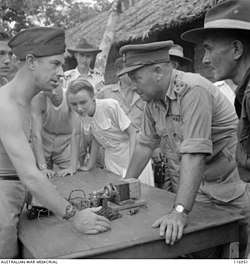Tom Eastick
Brigadier Sir Thomas Charles Eastick, CMG, DSO, ED (3 May 1900 – 16 December 1988) was an Australian motor engineer and army officer who rose to senior command in the Second World War. As a temporary brigadier, he was military governor of Sarawak in 1945 after taking the Japanese surrender at Kuching.
Sir Tom Eastick | |
|---|---|
 Eastick (second right) views a homemade radio constructed by prisoners at the Batu Lintang POW/internment camp | |
| Born | 3 May 1900 Hyde Park, South Australia |
| Died | 16 December 1988 (aged 88)[1] Somerton Park, South Australia |
| Allegiance | Australia |
| Service/ | Australian Army |
| Years of service | 1918–1946 1950–1953 |
| Rank | Brigadier |
| Commands held | Kuching Force (1945) Royal Artillery, 9th Division (1944–45) Royal Artillery, 7th Division (1943–44) 2/7th Field Regiment (1940–43) 13th Field Brigade, Royal Australian Artillery (1939–40) |
| Battles/wars | Second World War
|
| Awards | Knight Bachelor Companion of the Order of St Michael and St George Distinguished Service Order Efficiency Decoration Mentioned in Despatches Companion of the Order of the Star of Sarawak |
| Relations | Bruce Eastick (son)[2] |
| Other work | Military governor of Sarawak (1945) |
Early life
Eastick was born in Hyde Park, South Australia, on 3 May 1900.[1] He worked in an engineering business and was living in Reade Park, South Australia when the Second World War broke out. He was married to Ruby Sybil Eastick (née Bruce).
Military career
Eastick served with the Royal Australian Artillery (RAA) during the Second World War. From 1 November 1939, as a lieutenant colonel, he commanded the 13th Field Brigade, RAA. From 26 April 1940 he commanded the 2/7th Field Regiment, and led it during the North African campaign, including the Second Battle of El Alamein. Eastick was Mentioned in Despatches on 15 December 1942,[3] awarded the Distinguished Service Order on 18 February 1943.[4]
In 1943 Eastick returned to Australia and, on 22 June, he was appointed commander of artillery with rank of brigadier for the 7th Division during the New Guinea campaign. In 1944 he then assumed the same position with the 9th Division.
By September 1945 Eastick had been appointed commander of Kuching Force, a detachment of the 9th Division which supervised the Japanese surrender in the territory of Sarawak, on the island of Borneo. Eastick oversaw the liberation and repatriation of Allied prisoners of war and internees in Sarawak, including the large Batu Lintang camp. He was military governor of Sarawak from 10 September 1945 until December 1945, when the territory returned to civilian rule. Eastick was subsequently made a Companion of the Order of the Star of Sarawak by the last White Rajah of Sarawak, Charles Vyner Brooke.
Eastick left the army on 27 February 1946 with the substantive rank of colonel and the honorary rank of brigadier. He was recalled to service in 1950 and promoted to the substantive rank of brigadier to command Headquarters Group, Central Command. He retired from the army a second time on 1 October 1953.[1]
Post-war career
Eastick was later president of the Returned and Services League of Australia (the main Australian veterans' organisation) in South Australia, and was appointed Companion of the Order of St Michael and St George (CMG) in the 1953 Coronation Honours for his work with this organisation.[5][6]
The announcement of Eastick's knighthood was made in the 1970 New Year Honours.[7] It was conferred on him in person by Queen Elizabeth II on 24 April 1970 at Government House, Canberra.[8]
Notes
- Brook, David N. (2007). "Eastick, Sir Thomas Charles (Tom) (1900–1988)". Australian Dictionary of Biography. 17. Melbourne University Press. ISSN 1833-7538. Retrieved 25 March 2016 – via National Centre of Biography, Australian National University.
- "Family Notices". Saturday Journal. XLII (16412). South Australia. 29 October 1927. p. 29. Retrieved 25 March 2016 – via National Library of Australia.
- "No. 35821". The London Gazette (Supplement). 11 December 1942. pp. 5437–5446.
- "No. 35908". The London Gazette (Supplement). 16 February 1943. p. 863. (DSO)
- "No. 39863". The London Gazette (Supplement). 26 May 1953. p. 2944.
- http://www.woomera.com.au/community/gibber_gabber/2006/21_Apr_06.pdf Archived 19 August 2006 at the Wayback Machine
- "No. 44999". The London Gazette (Supplement). 30 December 1969. p. 2.
- "No. 45098". The London Gazette. 12 May 1970. p. 5343. (KtB conferred)
External links
- generals.dk "Eastick, Sir Thomas Charles, Brigadier (1900–1988)", www.generals.dk, access date: 4 April 2007.
- "Thomas Charles Eastick", ordersofbattle.com, access date: 4 April 2007.
- "Looking anew at Japanese surrender", 5 October 2005, The Malaysian Star. Newspaper article about Eastick in Kuching.